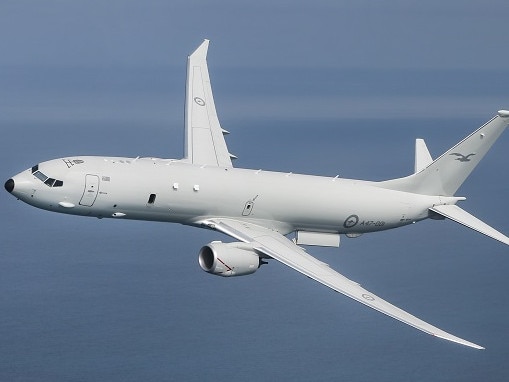
Marles said that after flying close to the side of the P-8 and releasing a flair, “the J-16 then accelerated and cut across the nose of the P-8, settling in front of the P-8 at very close distance. At that moment, it then released a bundle of chaff which contains small pieces of aluminium, some of which were ingested into the engine of the P-8 aircraft.”
It’s unlikely the chaff would have been sufficient to cause an engine failure on the P-8, but it is a dangerous and aggressive move, signalling a new level of Chinese military assertiveness combined with a lack of professionalism in the People’s Liberation Army Air Force.
That’s a potentially deadly combination which could well see incidents leading to the loss of aircraft and flight crew. A downing of a military aircraft over the South China Sea would create serious doubt about the safety of commercial airlines in the region and plunge Australia-China relations into even deeper distrust.
Marles says his government remains committed to operating surveillance flights through the South China Sea, correctly noting that Australia was “within our rights and international law to assure that there is freedom of navigation in the South China Sea, because that is fundamentally in our nation’s interest”.

Continuing Australian surveillance operations will require rethinking how they are conducted and should also lead the government to consider how to put more international pressure on Beijing to change its military behaviour. We are regularly told that the Albanese government will deliver smarter, more engaged diplomacy. Here is a great opportunity to show how that can be done.
Australia is not the only target of aggressive and dangerous PLAAF behaviour. A Canadian CP-140 Aurora surveillance aircraft has also recently been targeted when operating out of Japan to enforce United Nations sanctions against North Korea.
On June 1, the Canadian Defence Force released a statement saying that “PLAAF aircraft did not adhere to international air safety norms” and were “unprofessional” in forcing a Canadian aircraft on several occasions to “avoid a potential collision with the intercepting aircraft.” Chinese combat aircraft fly daily into Taiwan’s Air Defence Identification Zone, which is not illegal but is clearly designed to test Taipei’s response capabilities. There are signs that the constant scrambling of aircraft reacting to PLA incursions is damaging Taiwanese air readiness.
At sea, in the past couple of years, Chinese “fishing vessels” have been used to ram Japanese and Taiwanese naval ships.
In 2020, a Chinese warship locked its weapons targeting radar on a Philippines naval vessel, an act that signals an imminent missile launch.
Naval vessels of any country operating in the South China Sea are routinely subject to aggressive behaviour from PLA Navy and coast guard ships. The smaller and generally less capable navies of Southeast Asian countries are regularly harassed by Chinese “fishing boats”, coast guard and increasingly the PLA Navy in efforts to reinforce Beijing’s illegal claim of sovereignty over contested islands. This broader pattern of activity shows that heightened PLA aggression is sanctioned by Beijing. Individual PLA units may devise their own tactics, some sensible and others too dangerous even for their own safety, but the overall effect is designed to raise the costs of any encounter with the PLA.
Chinese military planners will have thought through the likely consequences of PLA actions leading to the downing of a foreign aircraft or sinking of a ship. If high-risk PLA behaviour continues, that means Beijing’s generals and Communist Party leaders don’t think an incident like that would really damage their broader strategic objectives.
In 2001, a Chinese fighter pilot, Wang Wei, died when his aircraft clipped a US intelligence-gathering P-3C surveillance aircraft near Hainan Island in the South China Sea. Wang is today lauded as a martyr, has been given the title of “Guardian of Air and Sea” and is used in CCP propaganda to promote defence recruiting.
A serious risk here is that over-enthusiastic displays of patriotic zeal on the part of PLA pilots and naval officers could well lead to more risky military interactions. The pilot of the J-16 that intercepted Australia’s P-8 is more likely to be lauded for his actions than disciplined for unprofessional behaviour.

Marles’ decision to reveal the detail of the incident publicly is an important way to overtly highlight the high risks of a military incident in the South and East China Seas. It contrasts with the Defence Department’s earlier tight-lipped media statement about a “dangerous manoeuvre” which ended by saying “Defence will not be commenting further on this matter”.
Marles should reach out to his Canadian counterpart and to other defence ministers with interests in Indo-Pacific security to develop a shared position countering the PLA’s increasingly risky behaviour.
It’s clear that the PLAAF aircraft did not follow international air safety norms. China is a member of the Chicago Convention and the International Civil Aviation Organisation, which acts to set “standards and procedures for peaceful global air navigation.
This is the right moment for Australia to raise concerns about the security of civil aviation in the South and East China Sea.
Beijing is sensitive to co-ordinated criticism of its bad behaviour. Just as there has been an organised international push back against China’s cyber hacking and intellectual property theft, so too should the PLA’s increasingly Russian-like risk-taking be both highlighted and condemned.
In Jakarta, Anthony Albanese stressed “plans to elevate our defence co-operation” with Indonesia and condemned “the actions of China in this area as being an act of aggression and a dangerous act against the Australian Air Force”. An obvious area for expanded defence co-operation would be to assist the Indonesian air force and navy to strengthen its own presence in the South China Sea and to help prepare them to manage their own risky encounters with the PLA.
Labor has made the right call to continue surveillance patrols in the South China Sea. These patrols could be strengthened by adding combat aircraft to accompany the P-8s or by internationalising the activity and joining with units from Japan and the US.
The recent close calls with PLA aircraft show a clear trend towards greater military risk in our region. Australia can’t back away from maintaining our own strategic interests, but neither will China. We and our friends and allies should be ready for more military incidents.
Peter Jennings is the former executive director of the Australian Strategic Policy Institute.







Information released by Richard Marles on Monday about the incident between a J-16 Chinese combat aircraft and an Australian P-8 surveillance plane over the South China Sea is deeply concerning.